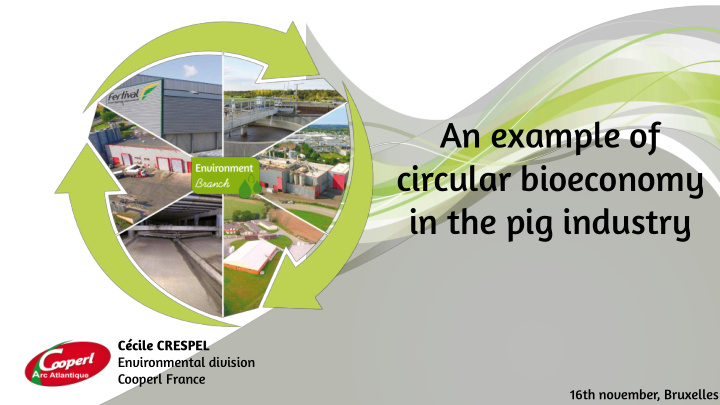



An example of circular bioeconomy in the pig industry Cécile CRESPEL Environmental division Cooperl France 16th november, Bruxelles
Cooperl Arc Atlantique is a leading french pig production cooperative 5,300 employees 2,700 members 5,700,000 porks N ° 1 in France 13 MILLION consumers in the world
Control throughout the chain Farmer Consumer Building Technical Feed Slaughter Shoulder Dénitral Défi Viandes Equipment Construction Procurement Cutting Belly CEDEV Health Pre-packed Ham Fertival Efficiency STEP Genetics Combioval Piglets Coproducts
Context in Brittany 35% of Cooperl pig production in High concentration Cooperl industrial In Brittany : site area - 480 pigs/ km ² UAA 65% of Cooperl pig Cooperl production 275 000 t of organic fertilizer production in area is in the Brittany north-west of from pig production France to manage. Many actions implemented for sustainable fertilization, that has given encouraging results.
Actual pig production cycle Crops Manure Manre Waste water
Industrial pig manure valorization Producing high standard fertilizers: 300 000 tonnes of pork by-products treated • per years DENITRAL • 60 000 tonnes of pig manure by-produtcs dryed WASTE WATER TREATMENT PLANT • 40 000 tonnes of slaugterhouse slurries dryed FERTIVAL: • 50 000 tonnes of natural fertilizers sold in France and abroad
Industrial by-product valorization Producing renewable energy and added value products: RENEWABLE ENERGY PRODUCTION PETFOOD and AQUAFEED INGREDIENT • • - 200 000 tonnes of steam produced from RECYCLED WATER biomass and intern biofuel • - 1 400 000 m3 of waster water - Heat used for Coopel food and - 60% of the water is recycled and used for environment industry external use and non-food industry BIOFUEL PRODUCTION • - 12 500 tonnes of biofuel produced from food industry fatty waste SMELL MANAGEMENT •
Next Cooperl pig production cycle Crops Manure Waste water Biogas s injecti ection on for Lamb mballe alle City
TRAC system Cooperl develop technologies to improve the value of the manure transfered to the industry. Multiples benefits for farmers Reduce the spraying surface (export of solid part) Participate to recover the P , N and OM Increase the animal wellfare Decrease 50% of NH3 emissions Available for existing builings Liquid part Solid part
To conclude All by-products from the pig industry are valorized as added-value products or as energy. Cooperl can created added-value thanks to its centralized position and industrial management. Main advantages: - Control the cost - Complain to European sanitary regulation To be sustainable, the system has to be build between farms and industries. - Farms provide by-products raw materials. - Industries provide innovative technologies. - Farms and industries share cost and benefits of a circular system.
Cecile CRESPEL ccrespel@cooperl.com Thank you for your attention !
Recommend
More recommend